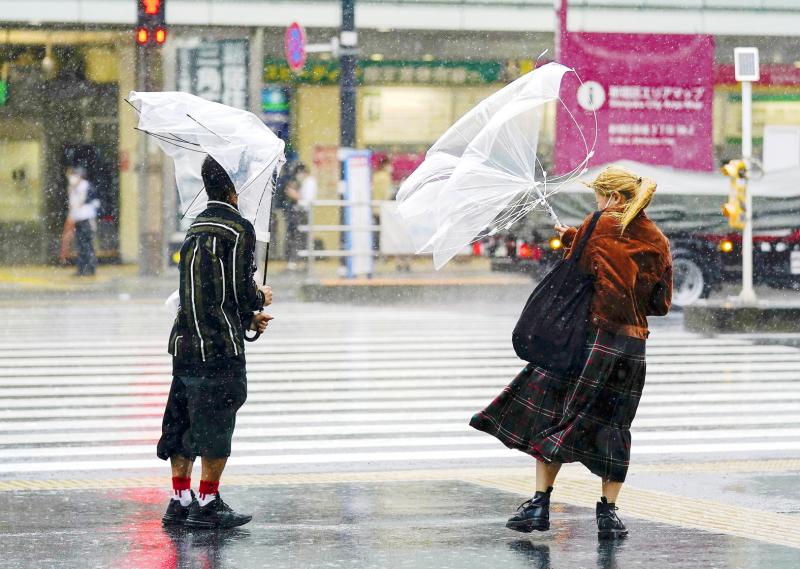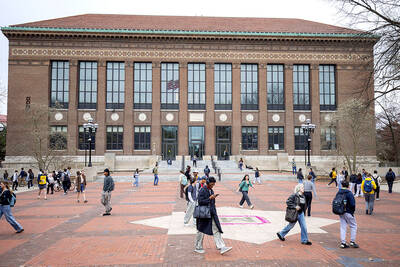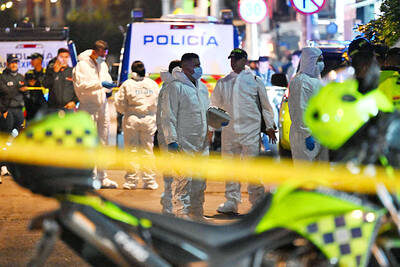Japan has fully come out of a state of emergency for the first time in more than six months, as the nation started to gradually ease COVID-19 measures to help rejuvenate the pandemic-hit economy.
At Tokyo’s busy Shinagawa train station, a sea of mask-wearing commuters yesterday rushed to their work, despite an approaching typhoon, with some returning to their offices after months of remote work.
The emergency measures, in place for more than half of the country, including Tokyo, ended on Thursday following a steady fall in new caseloads over the past few weeks, helping to ease pressure on Japanese health care systems.

Photo: EPA-EFE
Outgoing Japanese Prime Minister Yoshihide Suga thanked the people for their patience and cooperation, and asked them to stick to their basic anti-virus measures.
“Once again, I seek your cooperation so that we can return to our daily lives feeling safe,” he said.
The lifting of the emergency marked a fresh start for some people.
Office worker Akifumi Sugihara, 46, said he is back to the train station for the first time in about a year.
“I had been working from home for more than a year, and I came to the office in Tokyo as [the emergency] was lifted today,” he said. “It’s really been a while. I feel it’s a new start.”
Another office worker, Kaori Hayashi, 37, said it was an ordinary Friday.
“In my mind nothing really has changed,” she said. “We still need to be careful. I will stay vigilant and carry on my life as usual.”
Japan is eager to expand social and economic activities while balancing the need to prevent another wave of infections as the weather turns cooler.
Officials say the government still needs time to create more temporary COVID-19 treatment facilities and continue vaccinations to prepare for any future resurgence.
The emergency measures have mainly involved requests for eateries to curb alcohol and hours. They can now serve alcohol and operate an hour longer, but still have to close at 9pm.
As of Wednesday, daily reported cases had fallen below 1,600 nationwide — less than one-10th of the peak in the middle of August of about 25,000. Experts attributed the declining numbers to the progress of vaccinations and to people increasing their social distancing efforts after being alarmed by the collapse of medical systems during the summer.
Nearly more than 59 percent of Japanese people have been fully vaccinated. Japan had about 1.69 million cases and 17,641 deaths from COVID-19.
In related news, a powerful typhoon yesterday pounded the nation some of its eastern islands with gusts and downpours of rain, grounding some domestic flights and halting trains. The Tokyo area was getting heavy rain and blowing wind at midday, but no injuries have been reported.
Typhoon Mindulle was near one of the Izu Islands off Tokyo’s southern coast, moving northeast at about 35kph and packing winds of up to 162kph, the Japan Meteorological Agency said.
Some local train services in Chiba and other prefectures east of Tokyo were yesterday temporarily suspended. Several flights and ferries connecting Tokyo’s Haneda airport and outer islands have been canceled.
Japanese Chief Cabinet Secretary Katsunobu Kato told reporters that no damages or injuries had been reported so far. He urged Izu islanders to stay indoors and avoid going near glass windows until the typhoon passes.
Rain up to 200mm were forecast on the Izu Island and 150mm in to Tokyo region by morning today.
The meteorological agency warned residents in the affected areas of possible flooding and mudslides.

Brazil, the world’s largest Roman Catholic country, saw its Catholic population decline further in 2022, while evangelical Christians and those with no religion continued to rise, census data released on Friday by the Brazilian Institute of Geography and Statistics (IBGE) showed. The census indicated that Brazil had 100.2 million Roman Catholics in 2022, accounting for 56.7 percent of the population, down from 65.1 percent or 105.4 million recorded in the 2010 census. Meanwhile, the share of evangelical Christians rose to 26.9 percent last year, up from 21.6 percent in 2010, adding 12 million followers to reach 47.4 million — the highest figure

A Chinese scientist was arrested while arriving in the US at Detroit airport, the second case in days involving the alleged smuggling of biological material, authorities said on Monday. The scientist is accused of shipping biological material months ago to staff at a laboratory at the University of Michigan. The FBI, in a court filing, described it as material related to certain worms and requires a government permit. “The guidelines for importing biological materials into the US for research purposes are stringent, but clear, and actions like this undermine the legitimate work of other visiting scholars,” said John Nowak, who leads field

‘THE RED LINE’: Colombian President Gustavo Petro promised a thorough probe into the attack on the senator, who had announced his presidential bid in March Colombian Senator Miguel Uribe Turbay, a possible candidate in the country’s presidential election next year, was shot and wounded at a campaign rally in Bogota on Saturday, authorities said. His conservative Democratic Center party released a statement calling it “an unacceptable act of violence.” The attack took place in a park in the Fontibon neighborhood when armed assailants shot him from behind, said the right-wing Democratic Center, which was the party of former Colombian president Alvaro Uribe. The men are not related. Images circulating on social media showed Uribe Turbay, 39, covered in blood being held by several people. The Santa Fe Foundation

NUCLEAR WARNING: Elites are carelessly fomenting fear and tensions between nuclear powers, perhaps because they have access to shelters, Tulsi Gabbard said After a trip to Hiroshima, US Director of National Intelligence Tulsi Gabbard on Tuesday warned that “warmongers” were pushing the world to the brink of nuclear war. Gabbard did not specify her concerns. Gabbard posted on social media a video of grisly footage from the world’s first nuclear attack and of her staring reflectively at the Hiroshima Peace Memorial. On Aug. 6, 1945, the US obliterated Hiroshima, killing 140,000 people in the explosion and by the end of the year from the uranium bomb’s effects. Three days later, a US plane dropped a plutonium bomb on Nagasaki, leaving abut 74,000 people dead by the